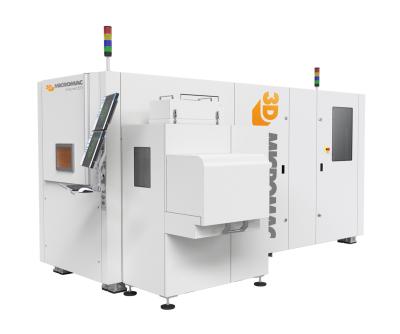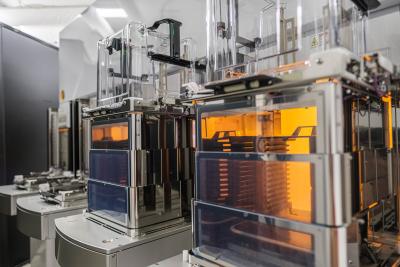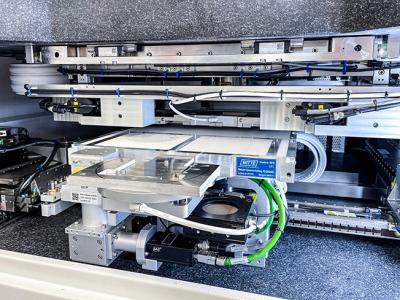Germany-based 3D-Micromac is the industry leader in laser micromachining and roll-to-roll laser systems. The company develops and manufactures processes and laser systems delivering powerful, user-friendly and leading-edge processes with superior production efficiency. 3D-Micromac offers industrial laser solutions for the mass production of microLED displays.
We had the pleasure of talking to Frank Richter, Head of Sales and Product Management at 3D-Micromac. Frank explained 3D-Micromac's solutions and technologies for microLED production, and the company's views on the future of microLEDs.
Q: Can you detail 3D-Micromac's solutions for the MicroLED market?
Frank Richter, Head of Sales and Product Management: 3D-Micromac’s product portfolio includes several laser-based system solutions for various manufacturing steps in the MicroLED production process. All systems offer an integrated process control and monitoring to assure stable and reliable operation thus enabling high throughput and low yield losses.
The microMIRA, a laser lift-off system, provides highly uniform, force-free lift-off of different layers on large-area substrates at high processing speeds without the need for costly and polluting wet chemical processes. The unique line beam system is built on a highly customizable platform that can incorporate different laser sources, wavelengths and beam paths to meet each customer’s unique requirements. The system is capable of processing different substrate materials and sizes, and can achieve processing speeds (including handling) of up to 60 eight-inch wafers per hour.
3D-Micromac’s microCETI system enables the cost-effective transfer of MicroLED devices by using the LIFT (laser-induced forward transfer) process. The high speed process allows the transfer of hundreds of millions of MicroLEDs per hour without having to apply mechanical forces – up to several orders of magnitude faster than other approaches – while the on-the-fly square-beam laser enables transfer of nearly any shape and size of MicroLED.
The third one – our microVEGA system – provides laser-based single-die repair via trimming process.
Q: How does laser-based LED repair work exactly? Can you explain?
After the LLO and/or the LIFT process defects may occur. Such defects might be shifted, tilted, defected and or polluted dies. These dies must be removed and refilled.
Using the microVEGA system the defects can be localized and removed from the substrate. This process is called trimming. Refill can be done using the microCETI system with single die transfer.
We understand that LLO is used to remove dies from the original epiwafer to a donor film, while LIFT transfers from donor film to the final substrate.
Q: Can you explain the technological difference between the two processes that complement each other in MicroLED production?
For the LLO process the epi-wafer is bonded to a donor/carrier.
The epi-wafer-donor stack is processed as one with a focus on throughput thus the technology focusses on high laser utilization with fast handling for autonomous production. After LLO is done the epi-wafer and the donor wafer are separated. Epi-wafer is transferred back to the epi process chain and the donor is used within next production steps.
For the transfer process (LIFT) the donor wafer is placed very close to the receiver (interposer or receiver). Typical distance is 60 – 100 µm. Then donor and receiver are moved according to the respective pattern and pitch. Therefore 16 axis are moved simultaneously.
The dies are released from the donor via the laser pulse and “flying” to the receiver. The flight itself including landing on the receiver is the critical part of the process.
Q: What are 3D-Micromac's main strength points for MicroLED production?
3D-Micromac has established itself as a leader in laser micromachining and as a pioneer of new production technologies for a wide range of industries for the last 20 years. This especially applies to the excimer and ultra-short pulse laser technology.
We have extensive experience applying innovative laser technology to new and emerging applications to support their volume-production requirements.
For MicroLED production ultra-high precision in combination with highest reliability and stability is needed. These are core competencies of 3D-Micromac.
Q: 3D-Micromac's solutions are based on UV lasers, is that a unique 3D-Micromac technology? How do these lasers compare to other lasers on the market?
As solution provider 3D-Micromac uses state of the art lasers for the tools. UV lasers can be either solid state or Excimer laser sources.
The Sapphire wafers are processed from the back thus the lasers must have a wavelength where the laser light is not absorbed. This wavelength is typically in the range of 230 to 270 nm .
Q: We understand you offer R&D systems, in addition to industrial-scale ones. Can you tell us how the market reacts to these systems?
Actually our systems create a lot of interest throughout the industry as µLED is one of the current key topics. Thus we have many talks to prospects and subsequent process demos.
We sold several systems for all the processes we offer and await more orders within the next months.
Q: Do you believe the MicroLED industry will change the way the display industry operates, or will the large display makers retain their dominance in the future as well?
There will be changes for sure especially for wearables and small displays however the manufacturing of large and comparable cheap displays is a different story.
Q: What are 3D-Micromac's roadmap in the MicroLED industry? What are your next steps to support the commercialization and scale-up of production for customers?
With the microCETI, the microMIRA and the microVEGA we are offering solutions for crucial processes within the µLED production. Our goal is to successfully grow our market share within the next year.
We are facing frequent questions for solutions of large scale displays so we are working on that.
Thank you Frank, good luck to you and 3D-Micromac. For more information on 3D-Micromac's solutions, click here.


